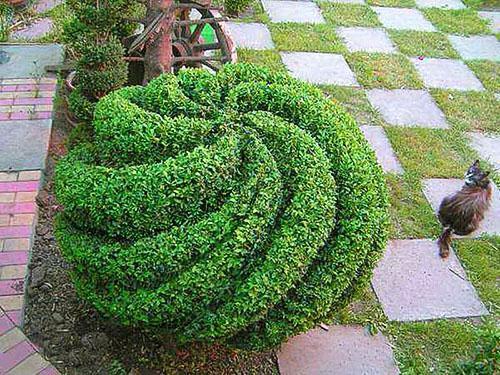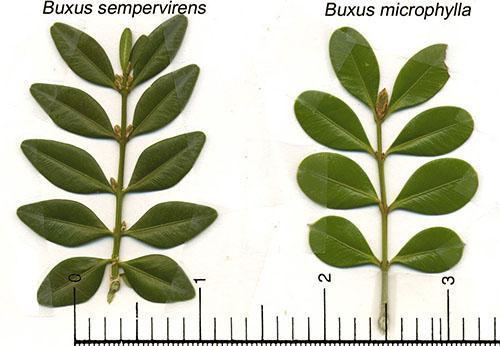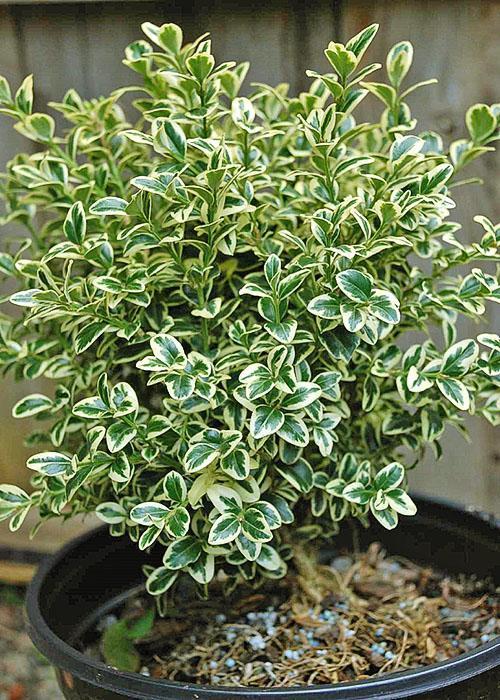Caring for boxwood at home
 Forming a dense, easy-to-cut and shaping crown, boxwood is one of the favorite plants of landscape designers. On the basis of this evergreen shrub with a dense compact crown and small leaves, not only green borders and living walls are created, but also amazing sculptural compositions.
Forming a dense, easy-to-cut and shaping crown, boxwood is one of the favorite plants of landscape designers. On the basis of this evergreen shrub with a dense compact crown and small leaves, not only green borders and living walls are created, but also amazing sculptural compositions.
Interest in culture today is greater than ever. What are the plant's requirements for keeping conditions, and how to care for boxwood so that the plant will delight for a long time with the brilliance of foliage and perfection of form?
In nature, there are more than four dozen boxwood species growing in the Mediterranean countries, in Southeast Asia and India, as well as in Africa and Madagascar.

The most famous cultivated plant of this vast family is the evergreen boxwood, followed by the small-leaved and Balearic boxwood. These species are used in landscaping cities and parks, and are also grown as indoor crops. Garland's whimsical boxwood is used to create miniature bonsai.
Growing boxwood and caring for it at home
 Distinctive features of all plant varieties are a low growth rate, glossy foliage, dense dense crown, as well as easy home care for boxwood. With the right approach, the plant becomes a real decoration of the home and garden, delighting the owner for many years with an unusual appearance and bright greenery.
Distinctive features of all plant varieties are a low growth rate, glossy foliage, dense dense crown, as well as easy home care for boxwood. With the right approach, the plant becomes a real decoration of the home and garden, delighting the owner for many years with an unusual appearance and bright greenery.
For boxwood to really feel comfortable, it needs conditions close to natural.
The plant perfectly spends the summer period on an open terrace, in a garden or on a balcony. At the same time, the boxwood needs to select places with good lighting, but we must not forget about protection from direct rays that burn young shoots and foliage.
 The ideal conditions for wintering indoor boxwood is a dry, closed room with a temperature of +6 to +16 ° С. If the plant is grown in a garden, it may suffer already at -10 ° C, therefore, garden bush and standard boxwoods must be provided with a reliable shelter until the frost passes. Caring for boxwood at home involves frequent and abundant watering... Boxwoods love moisture. Its hardness is not a critical indicator, however, plants do not tolerate watering with cold or chlorine water poorly. In order not to harm the pet, it is better to defend moisture in advance.
The ideal conditions for wintering indoor boxwood is a dry, closed room with a temperature of +6 to +16 ° С. If the plant is grown in a garden, it may suffer already at -10 ° C, therefore, garden bush and standard boxwoods must be provided with a reliable shelter until the frost passes. Caring for boxwood at home involves frequent and abundant watering... Boxwoods love moisture. Its hardness is not a critical indicator, however, plants do not tolerate watering with cold or chlorine water poorly. In order not to harm the pet, it is better to defend moisture in advance.
In the warm season, boxwood requires abundant watering, because without water it quickly begins to shed foliage and dry out. On hot days, boxwood responds well to spraying the crown.
 By autumn, the frequency of watering is reduced, and in winter, only occasionally, as necessary, they moisten the soil, making sure that the water does not stagnate and does not cause rotting of the root system. The lower the air temperature in the room where the boxwood is located, the less its need for watering, but the soil should not be allowed to dry out.
By autumn, the frequency of watering is reduced, and in winter, only occasionally, as necessary, they moisten the soil, making sure that the water does not stagnate and does not cause rotting of the root system. The lower the air temperature in the room where the boxwood is located, the less its need for watering, but the soil should not be allowed to dry out.
During the period of active growth, from spring to early autumn, the shrub is fed every 10-14 days, alternating mineral and organic additives.
From complex ready-made fertilizer mixtures for boxwood, the same compositions are suitable as for azaleas.
Reproduction of boxwood and care of seedlings
 In natural habitats, boxwood reproduces both vegetatively and by seeds that are formed in capsule fruits and literally shoot out as many meters after ripening.
In natural habitats, boxwood reproduces both vegetatively and by seeds that are formed in capsule fruits and literally shoot out as many meters after ripening.
To speed up the process and facilitate care, at home reproduction of boxwood is carried out using cuttings. You can get cuttings twice a year.
- In the summer months, young, recently lignified shoots at the base are cut for planting. In most cases, these cuttings can be obtained in June and July.
- In the last days of summer or at the beginning of September, you can also cut cuttings up to 10 cm long, containing 2-3 internodes.
The planting material is planted under a film in a moistened mixture of peat and garden soil.
At home, boxwood can also be propagated by layering obtained from young shoots inclined to the soil.
On such a branch, a cut of the bark with a fragment of wood is made and the shoot is pressed to the ground, securing this position with a wire bracket and directing the upper part of the layering vertically. Rooting boxwood can take up to three weeks. You can speed up the process with the help of growth stimulants, regular watering and a little heating of the soil. When young plants give roots, they are planted at a distance of 10 cm from each other or in separate small pots.
How to transplant boxwood?
 To transplant young seedlings and already mature boxwood bushes, you need a soil mixture with a neutral reaction, consisting of:
To transplant young seedlings and already mature boxwood bushes, you need a soil mixture with a neutral reaction, consisting of:
- two parts of humus;
- the same amount of sand;
- one part of turf land;
- a small amount of fine charcoal.
If the soil is too loose, add a little clay to it. This is especially important when planting a boxwood intended for bonsai and which subsequently does not transplant for a long time.
All types of boxwood require good drainage of fine gravel or stone chips with coarse sand.
 The best time to transplant is spring. During the warm months, the plant will have time to acclimatize, and winter will become less of a challenge for it. The new pot should not be overly large, especially when it comes to replanting an adult bush.
The best time to transplant is spring. During the warm months, the plant will have time to acclimatize, and winter will become less of a challenge for it. The new pot should not be overly large, especially when it comes to replanting an adult bush.
 How to transplant store-bought boxwood with a closed root system? Often, in such plants, the roots grow through the drainage holes, and inside the container they are woven into a tight ball. In this case, such a lump cannot be tried to straighten or unravel. The roots that have got out on the walls of the pot are carefully cut off flush with the bottom, the lump together with the peat soil is removed from the container and carefully transferred into the prepared container and the prepared mixture is poured.
How to transplant store-bought boxwood with a closed root system? Often, in such plants, the roots grow through the drainage holes, and inside the container they are woven into a tight ball. In this case, such a lump cannot be tried to straighten or unravel. The roots that have got out on the walls of the pot are carefully cut off flush with the bottom, the lump together with the peat soil is removed from the container and carefully transferred into the prepared container and the prepared mixture is poured.
Boxwood pests and diseases
 Most cases of loss of visual appeal by a shrub, as well as damage to a plant by pests and diseases, are associated with a violation of the rules for caring for boxwood at home:
Most cases of loss of visual appeal by a shrub, as well as damage to a plant by pests and diseases, are associated with a violation of the rules for caring for boxwood at home:
- Excessive watering in the cold season leads to root rot and other boxwood diseases.
- Drying out of the soil and dry air in the room is the reason for the loss of foliage and drying out of the young parts of the shoots.
- If the air temperature remains above 18 ° С for a long time, then the boxwood also begins to lose leaves and weaken.
Neglect of feeding, frost damage and other factors also leads to the weakening of the plant. Boxwood diseases and pests affect the weak, emaciated specimens.
Among the pests that can quickly settle on a weakened plant are spider mites, boxwood gall midges and various types of scale insects. The leaves of the bush are affected by the larvae of miner flies, which lay their eggs in plant tissue.
 And more recently, boxwoods in our country and throughout Europe have a new enemy brought from East Asia. The boxwood moth, together with the seedlings, was first brought to Germany in 2006, then it was found in Holland, Switzerland and other parts of the Old World. And in 2012, caterpillars and butterflies were brought to Russia on the boxwood intended for landscaping the Olympic Sochi.Today, the pest causes serious damage to the wild plantings of the relic Colchis boxwood.
And more recently, boxwoods in our country and throughout Europe have a new enemy brought from East Asia. The boxwood moth, together with the seedlings, was first brought to Germany in 2006, then it was found in Holland, Switzerland and other parts of the Old World. And in 2012, caterpillars and butterflies were brought to Russia on the boxwood intended for landscaping the Olympic Sochi.Today, the pest causes serious damage to the wild plantings of the relic Colchis boxwood.
Modern insecticides and fungicides are used to control larvae, ticks and caterpillars on box trees. Sick and pest-affected shoots are cut and destroyed. At the same time, they must establish caring for the boxwood at home, providing the plant with proper watering, temperature conditions and feeding.
Crown formation and boxwood pruning
Since the boxwood does not differ in its growth rate, it is easy to cut it, giving the crown a variety of shapes.
 Since boxwood pruning affects the shoots of the bush, removing their tops leads to the beginning of active branching, the crown becomes even denser, and there is no gradual exposure of old branches, as in wild species. Thanks to competent pruning, boxwoods are grown at home as bonsai, formed in the form of standard trees, silhouettes of various animals, geometric shapes and other objects.
Since boxwood pruning affects the shoots of the bush, removing their tops leads to the beginning of active branching, the crown becomes even denser, and there is no gradual exposure of old branches, as in wild species. Thanks to competent pruning, boxwoods are grown at home as bonsai, formed in the form of standard trees, silhouettes of various animals, geometric shapes and other objects.
 Pruning boxwood will be most effective if done from April to July, when the plant's shoot and foliage growth rate is at its maximum. To form the crown, special templates are used today to help quickly and accurately create a conceived composition.
Pruning boxwood will be most effective if done from April to July, when the plant's shoot and foliage growth rate is at its maximum. To form the crown, special templates are used today to help quickly and accurately create a conceived composition.
What kind of beast is this? The whole boxwood is covered in cobwebs, the leaves are nibbled and yellow. Boxwood perishes. Looks like a boxwood moth, but I'm not sure. How to deal with it? Tell me the names of insecticides or fungicides
Yes, this is a boxwood moth and the fight against it is difficult. Give up early and you can try to save your plants. Treat all bushes with Dimilin. Packaging of the drug in an amount of 10 grams is diluted in ten liters of water. Then we pour the product into a spray bottle and spray each plant from all sides and into the bush. Repeat the treatment after 10 days and after another 10 days. Cut dry branches and burn.
Russian experts advise treating damaged plants with decis, decis pro, fastak, karate, fury preparations.